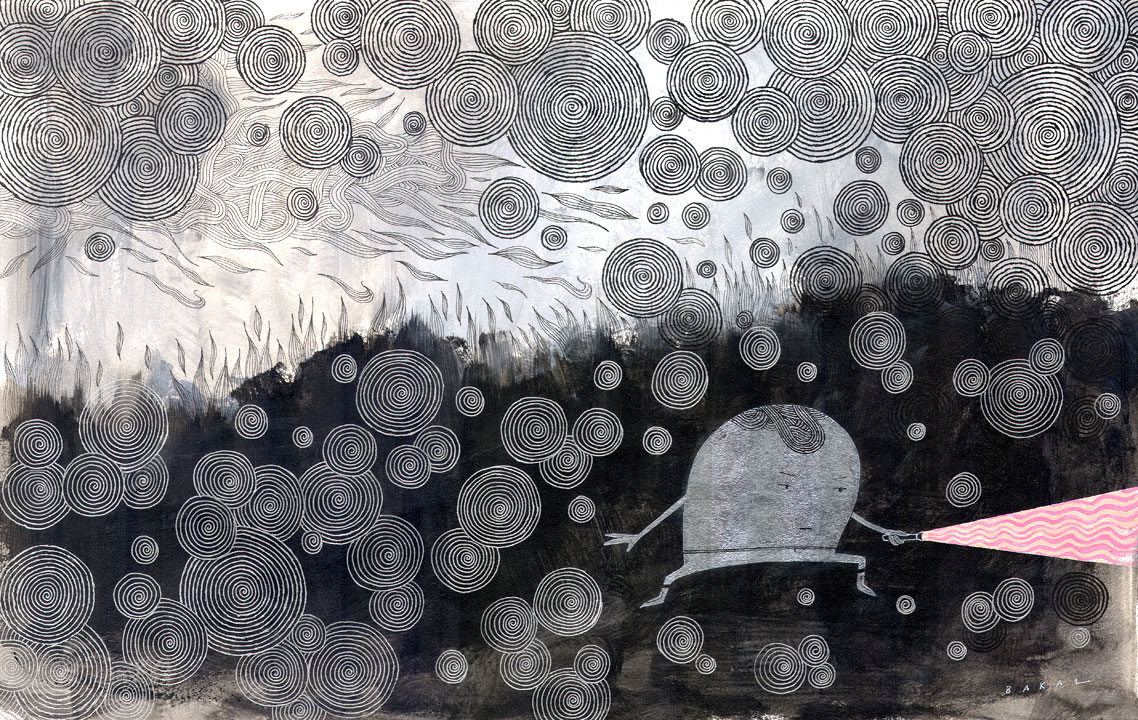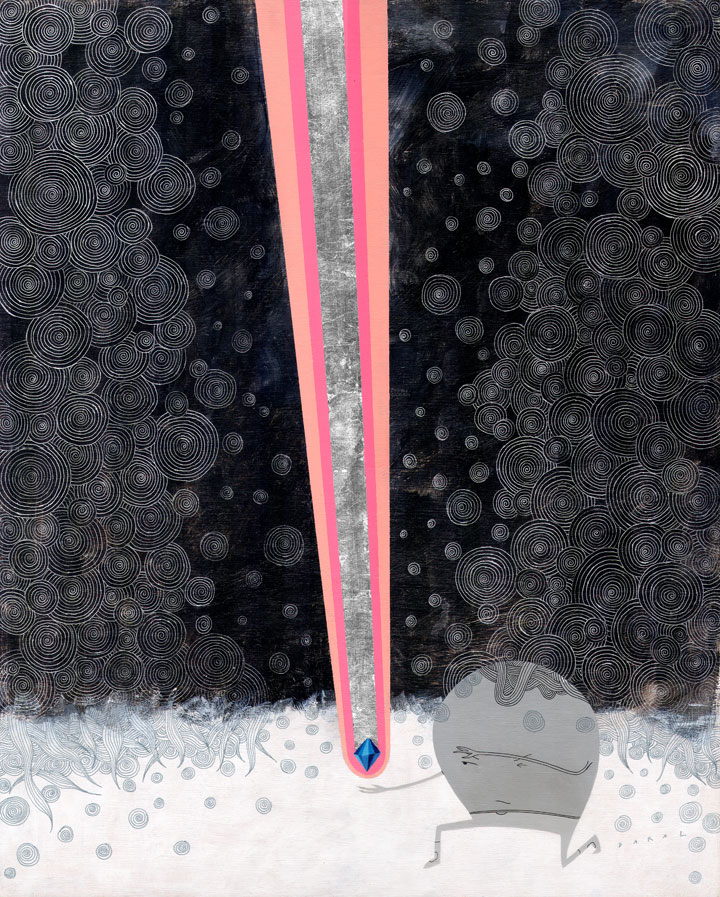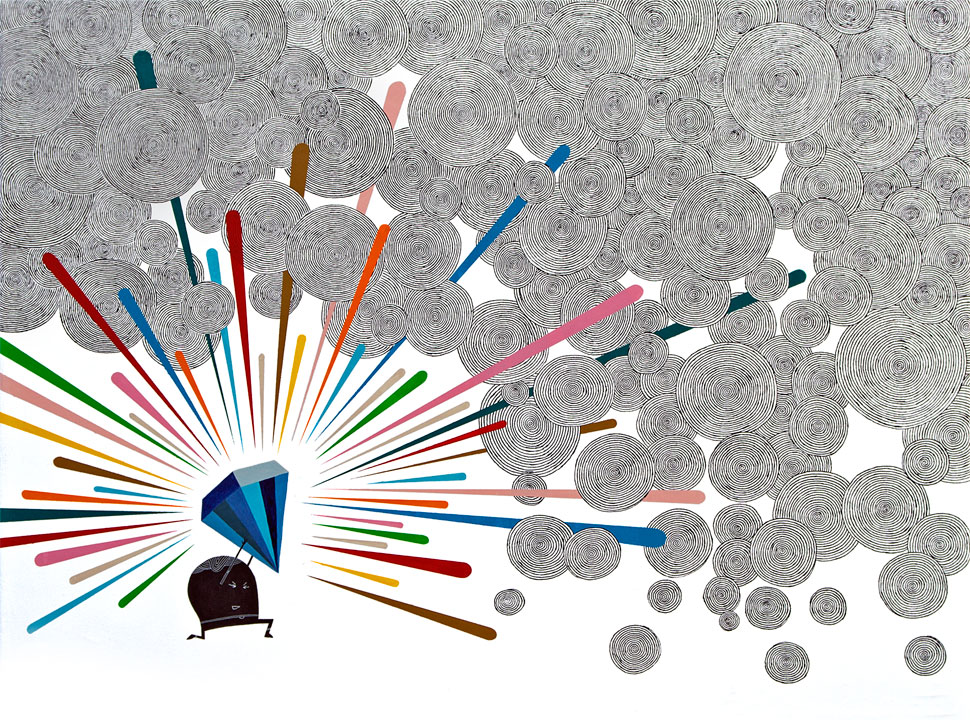Are you finding yourself pondering about going back to school for a Masters degree?
Frequently from students when I do lectures for illustration programs around the country and occasionally professionals as well, I am asked questions about going into a Masters program and whether it’s a good idea or not. It’s a topic sometimes revolving around a bad job market or fearful about making a living starting out as an illustrator and wondering if these sorts of degrees will help their chances getting work or help them improve as artists and illustrators. It’s a fair question.
My own story of how I decided to go into a Master’s program and which one I decided to select is complex and would require me to double the length of this post. If there is enough expressed interest, I may post about it. I spent years dismissing the thought of working toward anything higher beyond my BFA from School of Visual Arts. I finally made a decision when many variables lined up properly and it made sense to seek out a program and I choose one that would work for me.
These are some of the various questions I’ve collected that I’ve been often asked. Hopefully, this will help give some light on different facets of the decision to move forward and how to choose a program. If there are other questions, I will try to answer them in the comments below.
Do I need a Master’s Degree as an illustrator?
No, of course not. There are many artists that lack even Bachelor Degrees who have done quite well as illustrators.
When teaching, I tell students that they will likely go through their entire life as an illustrator and not a single client will ask about their grades or their schooling. If they do, it’s probably more conversational than a test. Art buyers want to see good work and a history of doing good work. Your art is what is going to get you hired, not the degree.
I’m not suggesting undergraduate or graduate education is pointless. A new artist does have to learn their craft somewhere if other sources are unavailable. In most cases, there just isn’t enough information to high school students or from their families to go out and find other educational angles to achieve the same goal outside the norm.
Do I need a Master’s Degree as a new illustrator?
Many students are thinking about going right into Master’s programs as they finish walking across the stage to collect their BFA degree. I’m often surprised about this. My usual comment about this is ‘before you jump right into a Master’s Program, are you sure you want to be or are even going to be an illustrator?’ I often get a giggle when I say this but it is a very important question, especially when we see the realities of how many illustration students do NOT remain illustrators.
I’ve recently spoke to someone I’ve known for a long while and she was a graduate from a top 10 art school. She got a full-time job in a related field in New York City while she got her act together to start illustrating. After a few years seeing first hand how the business works, she told me that she was going to end up in another field other than illustration. She met too many illustrators that just couldn’t earn enough and she wanted to, and I quote: “have a normal life…and that requires money”.
My usual recommendation for any student just leaving an undergrad program is to wait a couple of years and make sure that it’s where you want to be before you incur additional student loans which is a consideration and part of the equation.
There are exceptions to the rule. Everyone has his or her own path. I know quite a few current illustrators that went right from BFA to MFA and are doing well. But, I could count them on two hands compared to the thousands that graduate every year who don’t do well.
I might want to teach. Do I need a Master’s Degree to be a teacher?
The simple answer is no. The complex one is ‘maybe’.
At many schools around the country like my alma mater, School of Visual Arts; most teachers don’t need Master’s degrees because they are all considered ‘adjuncts’ at the school and professional experience is more important than a degree. To be an adjunct, a terminal degree is generally not needed. Also, a school like SVA is a private school so that system can be more flexible. It gets tricky if you want to teach at a university or state school. In those cases, yes, there may be rules in place that require all teachers, full time or even adjunct to have a Master’s. Some private schools are getting stricter about this rule as well because of rising accreditation standards.
If you want to teach full time, then most likely, yes, you’ll need a Master’s degree. At the very least you may need to sign up for an MFA program as part of the terms to getting hired. To reiterate, it’s largely dependent on the school and their policies.
In short: a Master’s degree is becoming more and more important for getting hired as a teacher. If you want to have a wide range of possibilities and choices in selecting where you work if you decide to teach, then a Master’s is probably the best way to go.
But then you have to ask the question…
Do I even want to teach?
Teaching is not for everyone. Oddly, I’ve had conversations with illustrators who wanted to get a Master’s for teaching but never taught. I know artists who discovered they do not have the patience for teaching and/or academic environments. I strongly recommend teaching as an adjunct at one or two schools for a few years before making any decisions about an MFA for teaching purposes.
Which program should I sign up for?
Each program runs on its own logic and has its own strengths and weaknesses. There aren’t too many major MFA in Illustration programs out there so it should be fairly easy for anyone to research, visit and figure out what they want as artists and what the program can offer to fulfill those needs.
There were two schools I was considering and each offered what I wanted in different ways but for one of the programs, I would have had to be there consistently every week for the entire duration of the program. That was a problem. I’ve been away from the ‘student lifestyle’ and working as an illustrator for 10 years when I decided to go for it. I had life expenses that would require me to continue working so cutting any income out just couldn’t happen.
I decided on a ‘Low Residency’ program after honing it down to two schools. I chose the University of Hartford. NOTE: I actually started at Syracuse University but finished in Hartford – another complex story for another time. The ‘Low Residency’ model is meant to be a program for working illustrators and considered a ‘professional’ program. This means applicants are preferred to have (but not a rule) 5-10 years experience working in the field. Coming into that program, it was usually under the assumption that you had a significant client base and understood the business already. It’s not necessarily a program of drawing and painting classes either. If you want to improve on that, you certainly could but most wanted to expand themselves creatively in their own way and develop their businesses.
Figuring out what you want for yourself is very important and will help dictate which program you enter and whether it fulfills those needs. Do you want to improve artistically? Improve your business? Expand your teaching role? Each program tackles each of those questions differently. Being honest about yourself and what you want to improve in yourself will not only help dictate a program that works for you, but define what you want to leave a program with.
When I started a program a little over 10 years being a working illustrator, I was very keenly aware of what I needed and wanted to get out of a program which drove me to make sure that I got the education I wanted. This knowledge and experience made the costs and time commitment worth it.
Reflecting back 10 years since I started the MFA program, I can say that it was one of the best choices I’ve made as an illustrator.
If you’d like ask other questions, I’ll try to answer them in the comments below.
Scott Bakal is an award-winning illustrator, including being honored with the 3×3 Magazine’s Illustrator/Educator of the Year. He is an Associate Professor at the Massachusetts College of Art and Design.
Website: http://www.scottbakal.com











Thanks for posting Scott. Very nicely done. I know it's hard to post everything relevant to a big topic like this. Your illustrations always take me to a great place.
Scott – I followed you through the same low-residency program a few years later and just wanted to add that THE number one benefit for me was a highly professional, dare I say relentless, thesis advisor that pushed me far beyond what I was capable of. Cheers – Brian
Thanks, Bill. I spent a lot of time editing this one because of how large the subject matter and all the variable are. 🙂
Hi Brian! Yes!
I was in the inaugural class for Hartford and had just finished a thesis for the MA degree in Syracuse weeks earlier. When I started my Hartford thesis, I was searching for a personal way to handle my work but I got halfway through and realized that I was painting the same old crap.
Bill and Murray, while hesitant at first, believed in me and allowed me to start over the entire body of work three or four months before the entire project was due. (It was during the Spring meeting I dropped the bomb). Their support (as well as everyone else) and insight was instrumental in allowing me to trust myself.
All good things. Thanks for popping in, Brian and keep doing that awesome work you do!
Thank you for writing this Scott. Something we spoke about and it's good that you're putting it out here.
An acquaintance of mine had an artist friend, an artist who considered themself successful, who went back to school (UCLA) for a masters in – art history. The person felt that they didn't appreciate what went before, especially art other than painting, and so went back to school for that reason. And ended up getting their Ph.D. in art history, and becoming the Art Curator of a museum. There are many paths.
An acquaintance of mine had an artist friend, an artist who considered themself successful, who went back to school (UCLA) for a masters in – art history. The person felt that they didn't appreciate what went before, especially art other than painting, and so went back to school for that reason. And ended up getting their Ph.D. in art history, and becoming the Art Curator of a museum. There are many paths.
Hi Scott, Great post. I have mixed feelings about the MFA program. I have taught grad students and also on an MFA advisory board. I've had quite a few conversations about the value of an MFA. I know it's required by colleges for most teaching posts but aside from that I'm curious as to the perceived benefits vs costs. Why not do a workshop program instead? Illustration is not an academic pursuit per se. It's a commercial one. I've heard colleges say work experience isn't a substitute for an MFA degree. I'd love to hear why it was such a good decision for you. Congrats again on your post and excellent work!
There are many paths, indeed! Thank you for the comment!
Hi Robert,
“Why not do a workshop program instead?”
It would depend upon the trajectory and final goals of the artist in question. Yes, there are amazing workshops like the Illustration Master Class, Illustration Academy and others that could certainly be inspirational. But, they are generally for shorter time periods as well compared to a proper program. That might be a factor in that you may not be given the proper time that is needed to grow and develop. Just a thought.
There are actually so many different angles to what would be a good decision and considering expenses, as they reveal themselves to the artist, they can make a proper decision to choose. That's one of the reasons why I wrote this – just to give some basic ideas of why it may be beneficial or not to go through a Masters program.
Maybe I'll pen up something about my personal experience…we'll see. 😉
It is further required to be of some importance to deal with such kind of the sufficient principles and that one had to think in accordance with the same probabilities. online summarizing tool
Hello Scott,
thank you for your post! It helped my anxiety 🙂
I have been a BFA carrying adjunct Illustration teacher in a private undergrad school for 5 years, but what led me to seek out an MFA after all this time is that I know now that I will never move up from being an adjunct without one. And I love teaching!
I have signed up for the same Low res program at Hartford that you have gone to, but was experiencing pangs of fear because it's starting next month and I want to be sure I am doing the right thing, getting into these huge student loans… I want it to be worth it. So I stumbled on your article, and I think it's a sign to go ahead and do the damn thing :))))) Thank you again!!!
Interesting point you make in the beginning. I went for grad school immediately after my bachelor’s, since in my field that was more or less a requirement. And indeed, over time, I found out I wasn’t really interested in being in that field. It was problematic because I did spend a lot of time on that degree and sunk cost fallacy made me not make a break as early as I probably should have ?
Hi Doruk,
That’s really unfortunate but I hope that you did have some education that could translate into other interests. Usually, there is something that crosses over. Good luck!
Scott, thanks for the article. I have considered pursing the same MFA program but am concerned that the workload will be too much of a burden, on top of my full-time job and family commitments. Can you give us a ball park number, in terms of hours per week needed for such an endeavor? Thanks in advance.
Scott, thanks for the Post. I have considered pursing the same MFA program but am concerned that the workload will be too much of a burden, on top of my full-time job and family commitments. Can you give us a ball park number, in terms of hours per week needed for such an endeavor? Thanks in advance.